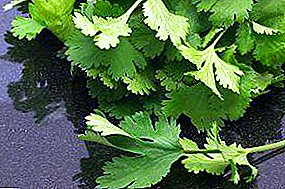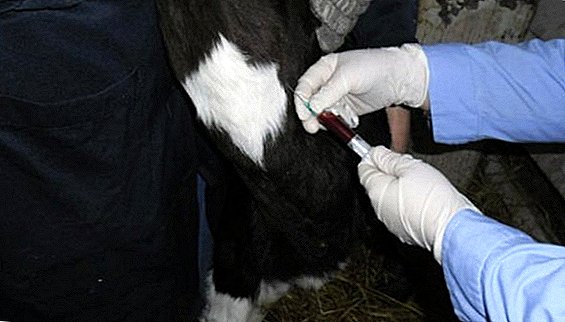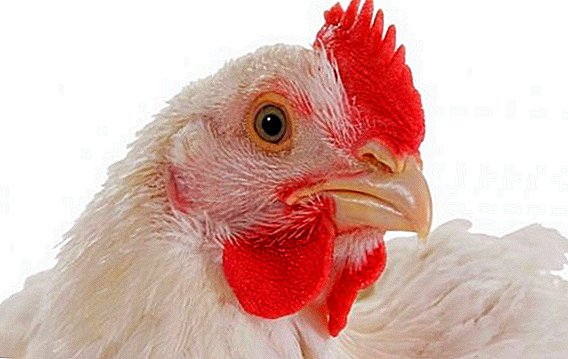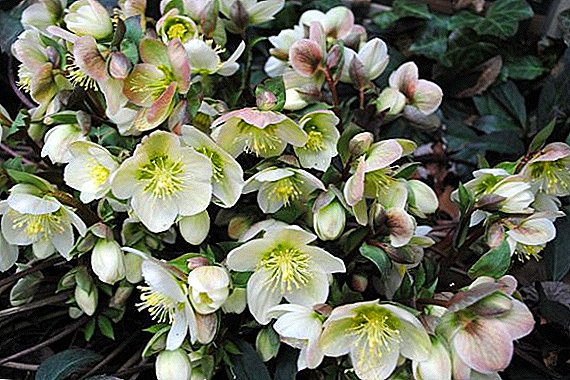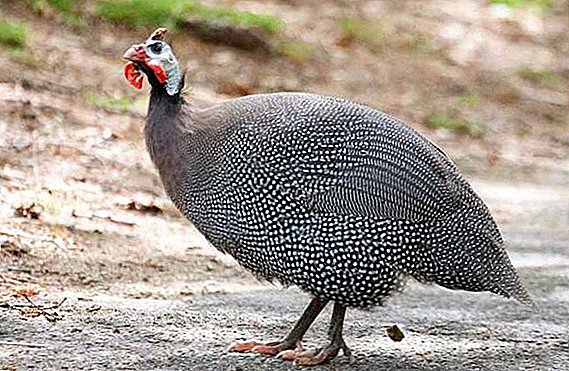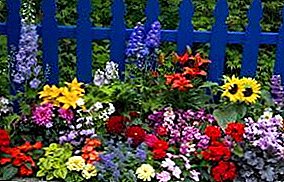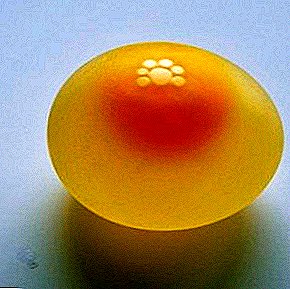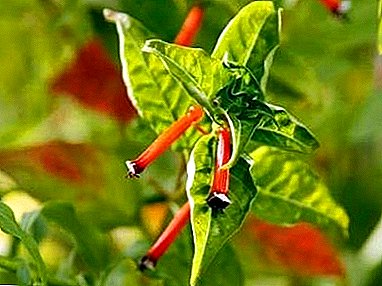
Kufeya is an unusual garden plant, which is most often planted in compositions for the sake of interesting tubular flowers.
Many people compare them with smoldering cigarette, because of what the plant itself is called "cigarette tree".
It is not demanding to care, however, for lush flowering will have to create favorable conditions.
general description
 Kufeya is a fast growing shrub. He belongs to the family Derbennikovsand the traditional habitat is Central and South America.
Kufeya is a fast growing shrub. He belongs to the family Derbennikovsand the traditional habitat is Central and South America.
Kufei comes from the Greek word "Kyphos"what means "hunched, crooked".
Indeed, its leaves and fruits bend a bit.
The plant has smooth dark green leaves of narrow shape. Stems in shrub species grow to a height of 40-50 cm. Flowers reach a length of 2-3 cm, can be red, white, purple and other colors. Flowering passes all warm period, from spring to autumn.
A photo
Flower kufeya photo:




Kinds
In nature, there are about 200 different types of kufei. Annuals in the process of growth reach a height of 1 meter. Perennial - usually small shrubs, are used when planting in concrete vases. The following types are most popular among gardeners and indoor plant lovers:
Fiery Red Gel
This flower is usually grown as a pot, but it can be planted with great success in a flower garden at the dacha. In the process of growth, it becomes a small bush, on which bright red flowers of tubular form bloom. You can propagate as seeds and cuttings. There are several subspecies: "Coan" flowers are brick red or cream, and "Dynamite" blooms before all other types of bright red flowers. Photo "Fiery Red Gel" look below:
Exalwood
A small bush plant from Guatemala and Mexico. Prone to heat, but can grow in rain and wind conditions. It grows in the form of a bush up to 50 cm high. As a rule, this species is planted in containers on balconies, in courtyards. Very easily propagated by cuttings. The flowers are white, pink or lilac, small, but usually a lot of them appear on the bush, and flowering time takes all summer. Below we can see the photo of the "copious" kufei:
Home care
Caring for the kufeya is not complicated, the main thing is to provide the conditions for temperature and abundant watering. Should not be allowed freezing the plant and staying in a draft.
Care after purchase
 Kufey can often be purchased in garden centers already in the form of ready-made plants.
Kufey can often be purchased in garden centers already in the form of ready-made plants.
After purchase, in without fail It is necessary to transplant in a new pot or on a bed of the site.
IMPORTANT!
To facilitate planting, the root system can be closed. special bagwhich provides easy separation of the plant from the soil.
However, if it is not removed, the fabric will stop flowing water to the roots, rotting and flower will begin will die. In addition, transplantation is carried out not by transshipment of an earthy coma, but by the fullest possible purification of the root system from the transport substrate.
Pruning
The plant very quickly reaches its maximum height, therefore it is necessary to constantly stimulate branching and the formation of a beautiful crown. Pinch the shoot tips and corrective pruning. If a perennial plant is grown, pruning is done early spring before the active development and preparation for flowering began.
On kufei fiery-red, they usually perform only pruning of extended shoots. On the scholar formation, more time is needed - due to the strong branching, this plant can be given the appearance of a ball or a pyramid.
Watering
In the summertime, room and garden kufa are poured in moderate amounts with water at room temperature. In the autumn, the procedure is performed 1 time in 2-3 days. In winter, the amount of water is reduced, but it is impossible to allow strong drying out of coma.
In spring and summer, during flowering, mineral fertilizers can be added to the water, at the rate of 20 grams per bucket.
Landing and ground
For planting kufei fertile nutrient soil is needed. You can make it yourself by mixing 1 part of leaf, humus, peat and sod land, and part of river sand. If this is not possible, then the purchase of a universal subacidic soil is allowed.
When growing kufei on the street, it is moved there after a significant increase in average daily temperature - best in late May or early June. Landing should be sunny, the soil is soft and fertile.
Transfer
 When growing kufei as a houseplant, it should be transplanted annually in early spring, before the beginning of the flowering period. At the same time, you can trim or nip.
When growing kufei as a houseplant, it should be transplanted annually in early spring, before the beginning of the flowering period. At the same time, you can trim or nip.
The pot is selected from any material, but with the obligatory presence of holes in the bottom. Size - 2-3 cm more in diameter than the former.
As soon as the capacity reaches 25 cm - transplantation is performed 1 time in 2-3 years. Down a thick layer of expanded clay drainage or brick dust is poured.
Growing up
Where to grow Kufa? Gardeners living in the southern part of the country can grow open-air caféas in the form of a one-year crop.
The flower is planted in the garden before the end Mayas soon as the probability of frosts passes.The place should be chosen with good lighting, but partial shade is allowed. You can not put Kufa in a damp place where there is no movement of air. The gap between the bushes should be at least 30-35 cm.
Breeding
The flower is propagated by cuttings or seeds.
The cuttings are cut from the top of the plant and planted in the ground in early spring, when the air temperature reaches +18 degrees or they are rooted in a glass of water.
 To ensure the shape of the bush can be planted in one place at once 2-3 process.
To ensure the shape of the bush can be planted in one place at once 2-3 process.
When the cutting starts to grow and it additionally grows three pairs of new leaves, the tip is pinched.
Seeds are sown in March-April, the main thing is to have a warm and bright sun. Ground they do not sprinkle on top. For the best shoot, it is desirable that the temperature outside is at least +18 degrees. You can also put the seeds in a bowl, close the package, and put it in a warm place. After germination, they are planted in disposable cups, and then as they grow into the ground or a large pot.
Temperature
Kufeya is thermophilic. In the summer, it grows well at room temperature + 22-25 degrees.
For the winter period it is reduced to + 12-18 degrees, but not lower.
The flower does not tolerate low temperatures and cold drafts.
When grown on the street, the bush is either used as a one-year bush, or it is dug out and transferred to the room for wintering.
Lighting
The plant should be in a bright place, with shading from direct rays. In the apartment it can be east or western windows. If there is not enough light, then the kufeya will not bloom, and the leaves will lose their color and will be dull. When getting sunburn they blush.
Benefit and harm
Plants are not poisonous or toxic.. In some countries, kufeyu planted for seed. They are made of fatty acids, which are used for industrial and domestic purposes.
Diseases and pests
Flower is not inclined to pest infestationnevertheless, a spider mite or a scythe can appear on it.
 When damaged by a spider mite, a thin white web appears on the leaves.
When damaged by a spider mite, a thin white web appears on the leaves.
At the initial stage, the plant should be gently washed with a soft sponge and soapy water.
In running form, after washing, it is still necessary to spray chemicals.
With the appearance of scythos on the leaves, brown bulges are clearly visible, which are the shells of these insects.
To combat it, you need to brush all the leaves on both sides with a brush and soap solution, mechanically clearing the pest. If necessary, after that, you can still treat with insecticides.
The appearance of gray spots on the leaves and rotting of the stem is the result of the appearance of fungi and gray rot. It is necessary to treat plants with fungicides against rot.
Attention! Being in a draft can cause a drop in the leaves.
Conclusion
Kufeya is a popular garden plant grown for bright flowers. It can be used both in the apartment in pots, and on a personal plot in an open ground. When you need care comply with the conditions for irrigation and lighting. Due to the rapid growth, constant pruning and nipping is required.


